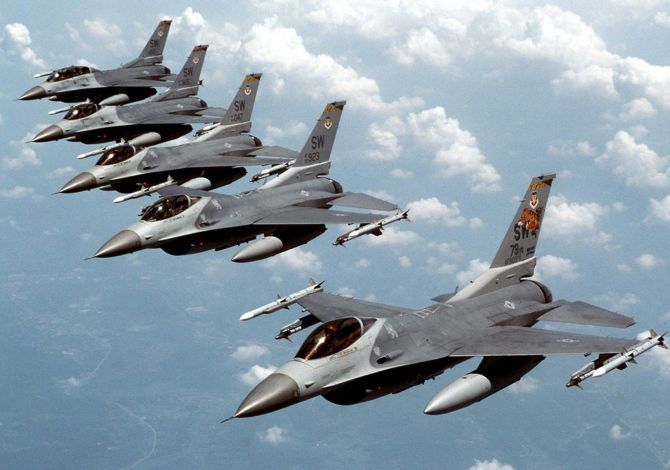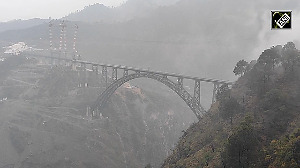With both aircraft likely to meet the IAF's performance requirements, the winning bid could be the one that offers the lowest cost and the best industrial proposal.
Ajai Shukla reports.

Lockheed Martin, the world's biggest defence vendor, which is pitching strongly to sell the Indian Air Force its new F-16 Block 70 fighter, says if India chose its fighter, an Indian production line would churn out 3 to 4 F-16s every month.
"We want to create the capacity to build three or more aircraft per month. We could do four. It depends upon how many aircraft India needs and when it will buy those," said Randy Howard, who markets the F-16 globally for Lockheed Martin.
For the IAF, which is making do with just 32 to 33 fighter squadrons instead of the 42 squadrons it wants to defend two borders with China and Pakistan, inducting 36 to 48 fighters per year would correct the shortfall quickly.
The Tejas production line in Bengaluru will build just eight fighters this year. It will take another two years to scale up to 16 Tejas annually.
Last year, even before the IAF solicited interest from multiple global aerospace vendors in building single-engine medium fighter aircraft in India, with transfer of technology to an Indian partner, Lockheed Martin announced a partnership with Tata Advanced Systems Ltd to manufacture the F-16 in India by shifting its production line from Fort Worth, Texas.
That mammoth, one-mile-long manufacturing line was once regarded as an industrial marvel on which 13,500 workers churned out one new F-16 every day.
But after the US Air Force bought its last F-16 in 1999, production tapered off to just 12 fighters per year.
Next month, after having built 4,588 F-16 fighters, the Fort Worth line will transition to building the fifth-generation F-35 Lightening II fighter that America and its allies have ordered in the thousands.
But with India undecided about buying the F-16, and uncertainty over the proposed India line, Lockheed Martin is re-establishing F-16 production in Greenville, South Carolina.
Countries like Bahrain and Indonesia are evaluating the acquisition of 19 F-16s and Lockheed Martin needs to keep the line alive.
If India decided quickly to buy the F-16 Block 70, Howard indicated production might shift directly to India instead of Greenville.
That would allow the Indian line to build fighters not just for the IAF, but also for Bahrain and Indonesia and any other global orders.
Lockheed Martin has aggressively marketed the F-16 in India against its key rival, Saab's new Gripen E fighter. The Swedish company is believed to be formalising a partnership with the Adani Group.
There is another dark horse contender amongst Indian companies: Hindustan Aeronautics Ltd.
With the HAL no longer establishing a production line for licence producing Rafale fighters in India, the public sector aerospace giant has pitched for building whichever single-engine medium fighter the IAF chooses.
The defence ministry has reserved the production of the single-engine fighter for the private sector under the 'strategic partner' policy which aims to build private defence industry.
Even so, it is not inconceivable that the government rules in favour of HAL given the lack of experience in the private sector.
The 'Make in India' programme demands indigenisation of over 50 per cent of the production of defence equipment.
Lockheed Martin executives claim they are ready to meet that target, having developed over 60 Indian suppliers in the Bengaluru-Hyderabad-Chennai area that will feed into F-16 manufacture.
Both Saab and Lockheed Martin claim they are offering India the better aircraft.
Saab points to the brand new technology on its Gripen E fighter, which is still being flight tested, while Lockheed Martin claims it is offering the world's most battle-tested combat aircraft.
With both aircraft likely to meet the IAF's performance requirements, the winning bid could be the one that offers the lowest cost and the best industrial proposal.






